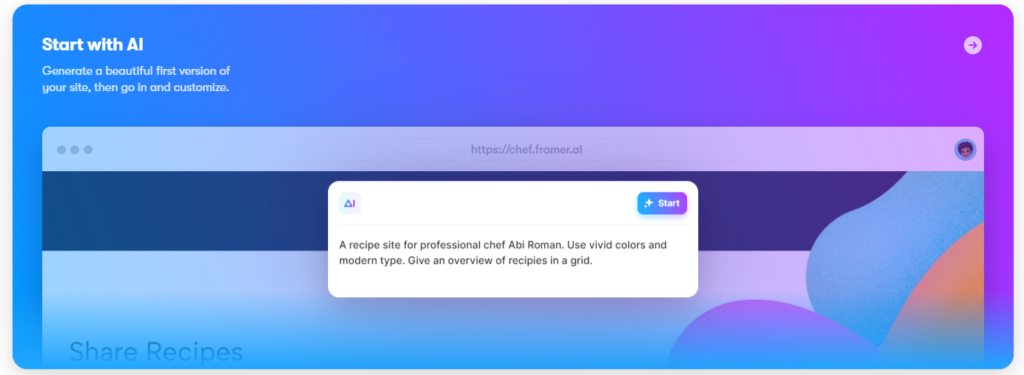Introduction: Exploring Framer.com‘s AI Integration and its Implications in the Design Industry

In today’s rapidly evolving design industry, staying ahead of the curve is crucial for professionals seeking to create innovative and user-centric experiences. With the integration of artificial intelligence (AI) into prototyping tools, such as Framer.com, designers are now equipped with a powerful ally that can revolutionize their creative process.
Framer.com’s AI integration takes prototyping to new heights by harnessing the capabilities of machine learning algorithms. This cutting-edge technology enables designers to automate repetitive tasks, enhance productivity, and push the boundaries of their creativity. By seamlessly integrating AI into their workflow, designers can unlock a world of possibilities and streamline their design process like never before.
The implications of Framer.com’s AI integration in the design industry are far-reaching. Designers can now focus more on ideation and conceptualization rather than spending excessive time on mundane tasks. The AI-powered prototyping tool assists in generating interactive designs, suggesting layout options, and even predicting user behavior patterns – all with remarkable accuracy.
Furthermore, this integration allows designers to iterate rapidly and efficiently by automating tedious processes such as resizing elements or adapting designs across multiple devices. With AI at their fingertips, designers can explore new design concepts faster than ever before while maintaining a high level of precision.
In conclusion, Framer.com’s AI integration is revolutionizing the design industry by empowering professionals with an intelligent prototyping tool that enhances creativity and efficiency. As technology continues to advance at an unprecedented pace, embracing these innovative solutions becomes essential for designers who strive to deliver exceptional user experiences in this ever-changing landscape.
Unleashing the Power of AI in Design with Framer.com
Framer.com is revolutionizing the world of design by unleashing the power of AI. With its advanced features and cutting-edge capabilities, Framer.com is taking design automation to new heights.
Artificial intelligence plays a crucial role in design, and Framer.com harnesses this technology to streamline and enhance the design process. By leveraging AI, designers can automate repetitive tasks, allowing them to focus on more creative and strategic aspects of their work.
One of the standout features of Framer.com is its ability to generate design variations based on user input. This intelligent system analyzes user preferences and automatically generates multiple design options, saving designers valuable time and effort.
Furthermore, Framer.com utilizes AI algorithms to assist with layout suggestions and color palettes. Designers can rely on these smart recommendations to create visually stunning designs that resonate with their target audience.
By integrating artificial intelligence into its platform, Framer.com empowers designers with powerful tools that amplify their creativity and efficiency. The possibilities are endless when it comes to leveraging AI in design, and Framer.com is at the forefront of this exciting movement.

The Pros and Cons of Framer.com‘s AI Integration: A Comprehensive Evaluation
Framer.com’s AI integration has been a game-changer for many designers and developers. It offers an innovative solution that combines the power of artificial intelligence with the intuitive interface of Framer. However, like any tool or technology, there are both pros and cons to consider when evaluating Framer.com’s AI integration.
One of the key advantages of Framer.com’s AI integration is its ability to streamline the design process. With AI-powered features such as automated layout suggestions and intelligent prototyping, designers can save valuable time and effort. This not only increases productivity but also allows for more experimentation and iteration in the design phase.
Another benefit is the enhanced collaboration that comes with Framer.com’s AI integration. The tool enables real-time collaboration, allowing multiple team members to work on a project simultaneously. This fosters better communication, reduces version control issues, and promotes a more efficient workflow.
However, it is important to acknowledge some potential drawbacks as well. One concern is the learning curve associated with using Framer.com’s AI integration effectively. While it offers powerful features, mastering them may require some time and effort from users who are new to this technology.
Additionally, there may be limitations in terms of customization options or compatibility with certain design workflows or platforms. It is crucial for users to thoroughly evaluate their specific requirements before fully committing to Framer.com’s AI integration.
In conclusion, while Framer.com’s AI integration brings numerous advantages such as streamlined design processes and enhanced collaboration capabilities, it is essential to weigh these benefits against potential challenges such as a learning curve or limitations in customization options. By conducting a comprehensive evaluation based on individual needs and preferences, one can make an informed decision about whether Framer.com’s AI integration is the right fit for their design workflow
Get Start Now
Click the promo code below to get 3 free months on a Pro annual subscription



Siteground: Siteground is known for its exceptional speed and advanced security features. They provide excellent customer support, automatic backups, and a user-friendly interface.
Siteground: Siteground is known for its exceptional speed and advanced security features. They provide excellent customer support, automatic backups, and a user-friendly interface. http://webward.pw/.